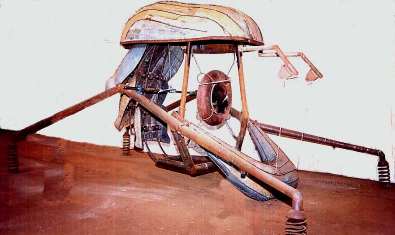CANNIBAL COMMUNICATOR
THE CONGO HOLOCAUST
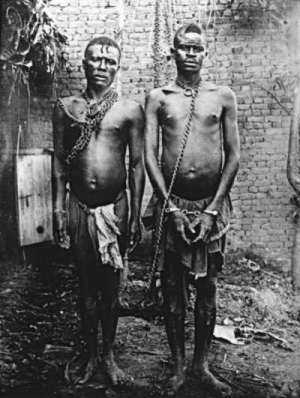
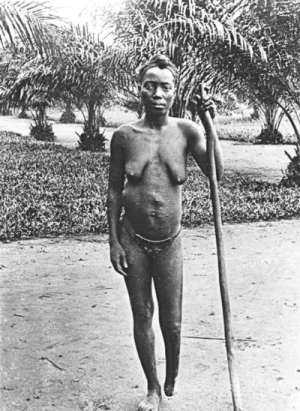
Introduction
I have approached this project from an African historical perspective. For much of Western Civilization’s history, Africa has been shrouded in myth and misunderstanding. The African tradition of oral communication ensured that Western understanding had to rely on painstakingly slow transcription by missionaries and explorers. A great many assumptions were made and the continent came to be viewed through preconceived Western cultural perceptions. Essentially, the Europeans were convinced that they were bringing culture and progress to undeveloped and backward peoples. This was seen as a philanthropic mission which was openly allied to imperialistic motivations. The Western literary tradition became part of the conquering process. And yet, when one reads accounts of those times, one is struck by the undying sameness of human nature. The heathen behaviors that the West regarded as cruel and barbaric, are repeated blithely by Western representatives in the occupied territories.
It is my thesis that a sub-text lurks beneath all human nature and infiltrates all relationships. I would epitomize this as the personality of Kurtz from Joseph Conrad's book, Heart of Darkness. This educated and sensitive man found himself within a foreign African culture and also with the means to subvert it to his own ends. The idea that power corrupts is in my view erroneous. The truth of the matter is that the will to power is indigenous to all organisms on a biological level. Power and greed are basic life forces that reflect the struggle for dominance. This biological struggle is also reflected in the phenomena of Capitalism and the institutions it gives rise to in order to organize and manipulate society. ( I should add that I see Communism as a sub-set of Capitalism, the main difference being hierarchical structure.)
Aim
This artwork intends to put together, in an interesting manner, a part of African history that is not very well known. The prime motive is educational, and the main beneficiaries will be schoolchildren and artlovers. It is a non-profit initiative and will be viewed at museums and community cultural centers. Initially the exhibition will be national, but I also hope to show it internationally.
Description of installation
|
The sculptural installation occupies a minimum space of 10 x 5 meters. It consists of a motorized mechanical component made from scrap metal and reminiscent of human and animal body parts. Forms reminiscent of skull, mouth-parts, necks and tail combine to express this. The structure has two moving sections which move in opposition to one another and in staggered sequences. Mobile parts which are connected to a motor and pulleys add an element of industrial animation. The main movement takes place at the front and back but the whole piece also quivers as though alive, because it is sprung. It suggests mastication with an ambiguous sensation of eating and talking simultaneously. There is a rubber car tube chained in the center, symbolizing the cause (i.e. rubber) of the human exploitation in that historical period. The center of the tube is filled with horse hair.
|
The sound system consists of a chain which emanates from the rubber tube or sphincter/oesophagus of the mechanical component and finishes in an old metal box which seems animated. The speakers seen through the grill look like eyes and the box has 4 legs like an animal.
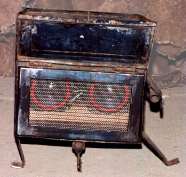
This box contains a sound system which relates the story of the Congo region. The soundtrack uses a ‘mechanical’ voice for the story which alternates with a normal human voice for quotes. The storyline extends from the adventures of Henry Morton Stanley in the late 1800’s, through the horrors of monopolistic capitalism imposed by King Leopold II of Belgium, to the ‘emancipation’ and withdrawal of colonial powers in 1960. The data is based on original sources such as diaries and is also drawn from reputable authors like Adam Hochschild ( King Leopold’s Ghost ) and Thomas Pakenham ( The Scramble for Africa) among others. The duration of the story is just over an hour long.
The box is placed in the centre of the organic component which consists of a leaning stick fence constructed from three sections, bolted together to form a ‘C’ shape. The wooden sticks that make the fence are topped by ‘heads’. These are carved out of palm tree core. Each fence section has four organic shapes protruding towards the centre. They are made from wire mesh that is coated with cooked grass to resemble land forms. The organic odour adds an element to the sensory experience. The rear side of the construction has three raised, 'burst' fibreglass panels which are coated in sand and coal dust and look somewhat volcanic.

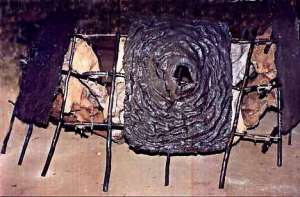
The overall metaphor is of an Indaba or meeting of the ancestors who are listening to the sound box which is placed in their midst, like a confessional. Essentially, I see the form as a conjunction of mouth/anus with the idea of consumption and broadcast of waste.
Positioned at staggered intervals surrounding the sculpture are eight freestanding frames that contain four light boxes each. The light boxes contain original photographs and drawings from the era. A large number of these are from the Congo Reform Association collection which is supervised by Anti-Slavery International. There are 32 lightboxes, each holding 2 images, thus 64 images.
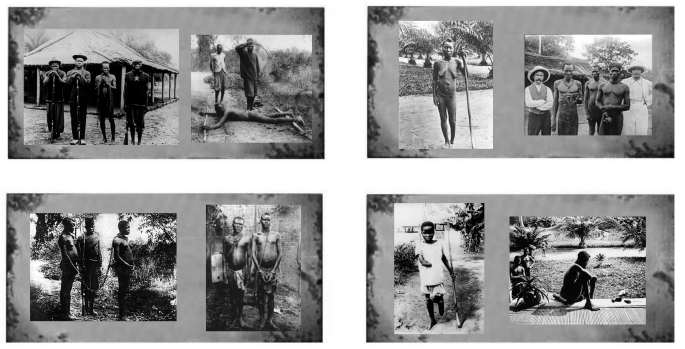
It is important to have this component, as viewers will need to be looking at things for the duration of the soundtrack. Text describing the individual photographs is included at the bottom of the images. I intend printing a small black and white book, to go with the show, which will contain the text of the soundtrack. Some of the photographs will also appear in this book.
The final component of the installation will be charcoal drawings which are semi-abstract visualizations suggested by the historical events related by the soundtrack. This element will complement the photographic documents in conveying a sense of the Congo Holocaust.
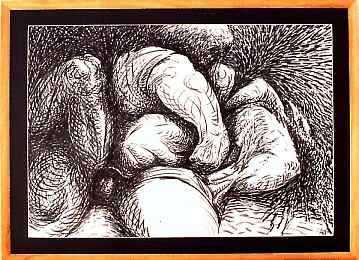
Reality
I believe very strongly that Western self-conceptualisation has to evolve in order to come into balance with the environment. In other words, our sense of self has to be deconstructed and reassembled anew to incorporate nature within it. We need to internalize on an emotional level the organisms and events that we experience. Metaphorically, we need to eat them and become whole with them. Ritualistic activities like eating the heart of an animal were meant to confer the qualities of that animal on the eater. We need to eat ourselves in order to renew our relationship with the land.
Our perception of Reality is based on fundamental conceptions like the separation of space and object, with time given as a constant. This type of thinking gives rise to the commonly accepted idea of cause and effect. Classical thought stems from Descartes and Newton who considered the universe to be made up of parts that interacted mechanically. However, Quantum Mechanics and Relativity have shown that our language and classical concepts are inadequate to express the experience of Reality. Indeed, at the macro and micro level, they are simply wrong. We need to reconceptualize our notion of space-time and the individual. We need to experience within ourselves the dancing energy that pervades everything. This sculptural situation piece should be viewed as a coagulation of multiple energies. It inhabits its thingness in order to be seen but it refers outward to flux. It embraces ambiguity because it knows that this is only a limitation of the describing language.
Conclusion
Dasart, the artists’ cooperative which I represent, is concerned with developing a new social reality. The art work I have described above forms part of this initiative and is an educational communication designed to combat racial intolerance and other subtle forms of slavery. The conception is very much like a confessional, or closer to home, the Truth and Reconciliation Commission. However, there is not a sense of atoning for sins committed, but merely the regurgitating of these experiences in altered form. Human nature is entered into very much in a state of flux. The story is not told chronologically but in bites of memory. In essence the history is treated as if it were food. There is no morality evident but my purpose is rather to exhibit a vision of human nature in action.
Ashley Johnson
Dasart
2002
